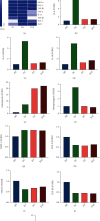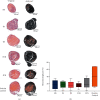Cytological Effects of Serum Isolated from Polytraumatized Patients on Human Bone Marrow-Derived Mesenchymal Stem Cells
- PMID: 34876907
- PMCID: PMC8645412
- DOI: 10.1155/2021/2612480
Cytological Effects of Serum Isolated from Polytraumatized Patients on Human Bone Marrow-Derived Mesenchymal Stem Cells
Abstract
Due to their immunomodulatory and regenerative capacity, human bone marrow-derived mesenchymal stem cells (hBMSCs) are promising in the treatment of patients suffering from polytrauma. However, few studies look at the effects of sera from polytraumatized patients on hBMSCs. The aim of this study was to explore changes in hBMSC properties in response to serum from polytrauma patients taken at different time points after the trauma incident. For this, sera from 84 patients with polytrauma (collected between 2010 and 2020 in our department) were used. In order to test the differential influence on hBMSC, sera from the 1st (D1), 5th (D5), and 10th day (D10) after polytrauma were pooled, respectively. As a control, sera from three healthy donors (HS), matched with respect to age and gender to the polytrauma group, were collected. Furthermore, hBMSCs from four healthy donors were used in the experiments. The pooled sera of HS, D1, D5, and D10 were analyzed by multicytokine array for pro-/anti-inflammatory cytokines. Furthermore, the influence of the different sera on hBMSCs with respect to cell proliferation, colony forming unit-fibroblast (CFU-F) assay, cell viability, cytotoxicity, cell migration, and osteogenic and chondrogenic differentiation was analyzed. The results showed that D5 serum significantly reduced hBMSC cell proliferation capacity compared with HS and increased the proportion of dead cells compared with D1. However, the frequency of CFU-F was not reduced in polytrauma groups compared with HS, as well as the other parameters. The serological effect of polytrauma on hBMSCs was related to the time after trauma. It is disadvantageous to use BMSCs in polytraumatized patients at least until the fifth day after polytrauma as obvious cytological changes could be found at that time point. However, it is promising to use hBMSCs to treat polytrauma after five days, combined with the concept of "Damage Control Orthopedics" (DCO).
Copyright © 2021 Yazhou Long et al.
Conflict of interest statement
The authors declare to have no potential conflicts of interest.
Figures







Similar articles
-
Comparison of chondrogenesis-related biological behaviors between human urine-derived stem cells and human bone marrow mesenchymal stem cells from the same individual.Stem Cell Res Ther. 2021 Jun 28;12(1):366. doi: 10.1186/s13287-021-02370-1. Stem Cell Res Ther. 2021. PMID: 34183056 Free PMC article.
-
MicroRNA-27b targets CBFB to inhibit differentiation of human bone marrow mesenchymal stem cells into hypertrophic chondrocytes.Stem Cell Res Ther. 2020 Sep 11;11(1):392. doi: 10.1186/s13287-020-01909-y. Stem Cell Res Ther. 2020. PMID: 32917285 Free PMC article.
-
hTERT- and hCTLA4Ig-expressing human bone marrow-derived mesenchymal stem cells: in vitro and in vivo characterization and osteogenic differentiation.J Tissue Eng Regen Med. 2017 Feb;11(2):400-411. doi: 10.1002/term.1924. Epub 2014 Jul 22. J Tissue Eng Regen Med. 2017. PMID: 25047146
-
Epigenetic Reprogramming via Synergistic Hypomethylation and Hypoxia Enhances the Therapeutic Efficacy of Mesenchymal Stem Cell Extracellular Vesicles for Bone Repair.Int J Mol Sci. 2023 Apr 20;24(8):7564. doi: 10.3390/ijms24087564. Int J Mol Sci. 2023. PMID: 37108726 Free PMC article.
-
Human mesenchymal stromal cells decrease mortality after intestinal ischemia and reperfusion injury.J Surg Res. 2015 Nov;199(1):56-66. doi: 10.1016/j.jss.2015.06.060. Epub 2015 Jul 2. J Surg Res. 2015. PMID: 26219205
Cited by
-
Uncovering impaired mitochondrial and lysosomal function in adipose-derived stem cells from obese individuals with altered biological activity.Stem Cell Res Ther. 2024 Jan 8;15(1):12. doi: 10.1186/s13287-023-03625-9. Stem Cell Res Ther. 2024. PMID: 38185703 Free PMC article.
-
Prenatal exposure to an environmentally relevant phthalate mixture alters serum cytokine levels and inflammatory markers in the F1 mouse ovary.Toxicol Sci. 2024 Sep 1;201(1):26-37. doi: 10.1093/toxsci/kfae084. Toxicol Sci. 2024. PMID: 38954831 Free PMC article.
References
-
- Unfallchirurgie D. G. F. Definition of polytrauma. 2020, https://www.dgu-online.de/patienten/haeufige-diagnosen/schwerverletzte/p....
-
- Frenzel S., Krenn P., Heinz T., Negrin L. L. Does the applied polytrauma definition notably influence outcome and patient population? - a retrospective analysis. Scandinavian Journal of Trauma, Resuscitation and Emergency Medicine . 2017;25(1):87–87. doi: 10.1186/s13049-017-0400-2. - DOI - PMC - PubMed
-
- Baker S. P., O'Neill B. The injury severity score: an update. The Journal of Trauma . 1976;16(11):882–885. - PubMed
LinkOut - more resources
Full Text Sources
Research Materials

